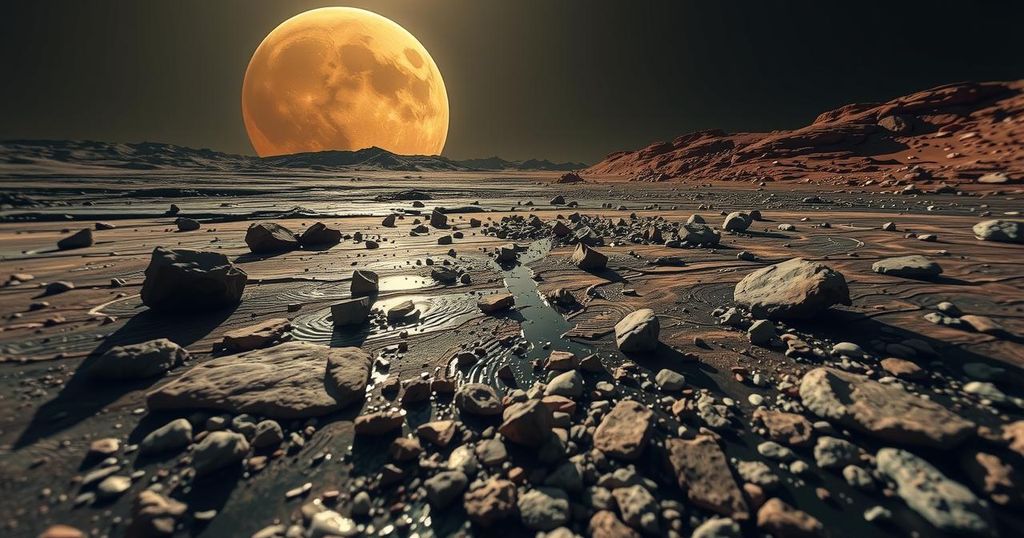Science
ARCHAEOLOGY, CLIMATE CHANGE, EARTH, ENVIRONMENTAL IMPACT, GLOBAL WARMING, INSIGHT LANDER, LANDER, MARS, NASA, NATIONAL ACADEMY OF SCIENCES, NORTH AMERICA, RED PLANET, SAN DIEGO, SCIENCE, SCRIPPS INSTITUTION OF OCEANOGRAPHY, SPACE EXPLORATION, UNITED STATES, UNIVERSITY OF CALIFORNIA, VA, VASHAN WRIGHT, WRIGHT
Liam Kavanagh
0 Comments
New Evidence Points to Liquid Water on Mars, Raising Hopes for Life
New research suggests large quantities of liquid water might be trapped deep beneath Mars’ crust, reviving hopes for potential life on the planet. A study reveals calculations based on seismic and gravity data indicating that these water reservoirs could have a volume exceeding that of ancient Martian oceans, providing a crucial ingredient for habitability.
Astronomers, fueled by new insights and data, have ignited hopes of unearthing life on Mars thanks to indications of substantial water hidden beneath its crust. Long ago, this enigmatic planet was a watery wonderland, boasting rivers, lakes, and perhaps oceans. Yet, over billions of years, these life-sustaining bodies dwindled, leaving behind mere icy remnants at the poles. However, scientists now propose that significant amounts of liquid water may still be sequestered deep underground, raising tantalizing prospects for astrobiology.
Recent calculations indicate that vast reserves of liquid water could exist within the Martian rocks at depths ranging from 11.5 to 20 kilometers. Dr. Vashan Wright, a co-author from the Scripps Institution of Oceanography, highlights the potential of this water, suggesting that it could eclipse the volume of ancient Martian oceans. The groundbreaking findings, published in the Proceedings of the National Academy of Sciences, draw on gravity data and seismic measurements from NASA’s InSight lander, revealing an intriguing reality of Mars’ geology.
According to Wright, a mid-crust wreathed in cracked rocks filled with liquid water fits the seismic and gravity profiles. He believes that if the conditions at the InSight site are representative of Mars as a whole, trapped water might fill a two-kilometer-deep ocean on this desolate world. This phenomenon parallels how groundwater infiltrates Earth’s crust, prompting scientists to consider whether similar processes occurred on early Mars, perhaps when its climate was more forgiving than today.
The discovery of water offers a promising yet cautious narrative. While the presence of water alone does not guarantee life, it stands as a crucial ingredient. Wright reflects, “We know that life can exist in the deep subsurface of the Earth, where there is water. The mid-crust of Mars at least contains a key ingredient for habitability and life as we know it.”
Not everyone involved in the study agrees on the implications of these findings. Bethany Ehlmann, a planetary science professor, emphasizes the need for specific measurements to confirm the existence and distribution of liquid water. She notes, “On Earth, where there is liquid water, there is life, so if liquid water aquifers are present on Mars now, they are a prime target in the search for life.”
Despite the optimism surrounding the potential for life, not all scientists share the same enthusiasm regarding resource accessibility for humans. Dr. Steven Banham acknowledges the significant amount of subterranean water, asserting that while promising, it may prove challenging to access. His viewpoint underscores the complexities of space exploration, reminding us that even with abundant resources, strategic navigation and technology are paramount for crewed missions to the Red Planet.
These illuminating discussions weave a narrative that speaks of possibilities—of waters flowing deep beneath a dusty red facade, harboring whispers of life in a long-lost Martian epoch.
The quest for extraterrestrial life has captivated humanity for centuries, with Mars often serving as the focal point of exploration. With its historical connection to water, scientists have long speculated about the rich aquatic past of the Red Planet and its potential for life. Recent technological advancements, particularly in seismic observation and gravity analysis, have offered fresh insights into Mars’ geology, enabling researchers to consider the depth and state of water that might remain trapped within its crust.
In summary, recent revelations from researchers regarding the existence of vast liquid water reservoirs beneath Mars’ surface rekindle hope for finding life on the planet. This possibility opens a new chapter in our understanding of Mars’ climatic history and its potential to support life. Scientists continue to emphasize the importance of validating these findings through further research and exploration, highlighting the delicate interplay between astrobiology and planetary science as we embark on the quest to uncover the mysteries of Mars.
Original Source: www.theguardian.com




Post Comment